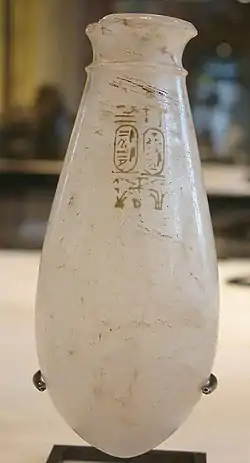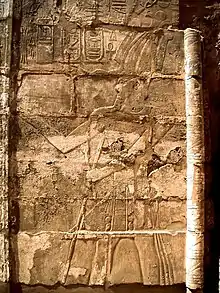Twenty-third Dynasty of Egypt
The Twenty-third Dynasty of Egypt (notated Dynasty XXIII, alternatively 23rd Dynasty or Dynasty 23) is usually classified as the third dynasty of the ancient Egyptian Third Intermediate Period. This dynasty consisted of a number of Meshwesh ancient Libyan (Berber) kings, who ruled either as pharaohs or independent kings of parts of Upper Egypt from 880 BC to 720 BC, and pharaohs from 837 BC to 728 BC.
Twenty-third Dynasty of Egypt | |||||||||
|---|---|---|---|---|---|---|---|---|---|
| 837 BC–728 BC | |||||||||
 Flask of Rudamun | |||||||||
| Capital | Thebes, Herakleopolis | ||||||||
| Common languages | Egyptian language | ||||||||
| Religion | Ancient Egyptian Religion | ||||||||
| Government | Absolute monarchy | ||||||||
| Historical era | Classical antiquity | ||||||||
• Established | 837 BC | ||||||||
• Disestablished | 728 BC | ||||||||
| |||||||||
| Periods and Dynasties of Ancient Egypt |
|---|
|
All years are BC |
|
See also: List of Pharaohs by Period and Dynasty Periodization of Ancient Egypt |
History
There is much debate surrounding this dynasty, which may have been situated at Herakleopolis Magna, Hermopolis Magna, and Thebes. Monuments from their reign show that they controlled Upper Egypt in parallel with the Twenty-second dynasty, shortly before the death of Osorkon II.
While the Twenty-third Dynasty is considered a Tanite dynasty, as in originating from the city Tanis, it never reigned from there. The Twenty-second Dynasty, coming from Bubastis, took over Tanis and Memphis and managed to retain these cities almost until the end of their Dynasty. As a result, the Twenty-third Dynasty, being more or less an offshoot of the Twenty-second Dynasty, originated from Tanis. Instead, as mentioned above, most historians argue that they used Leontopolis as their capital.[1] This is confirmed by Piankhy's stela, which locates Iuput II in Leontopolis.[2] However, some historians argue that Iuput II should not be considered a Twenty-third Dynasty king at all, as it has not been undoubtedly proven that the Twenty-third Dynasty ruled from Leontopolis, merely that Iuput II ruled from somewhere in the Delta.[3] And if Iuput II is the only connection between the Twenty-third Dynasty and Leontopolis, this viewpoint would eliminate Piankhy's stela as proof for Leontopolis being the capital of the Twenty-third Dynasty.
Another reason why there is much debate is because next to the conflicts between Lower and Upper Egypt that existed, there were now also conflicts in the Delta itself. Part of these conflicts were succession struggles, but another part of it were High Priests of Amun at Thebes, who for a period during the Twenty-first Dynasty effectively ruled Upper Egypt, despite not being regarded as a separate dynasty (however, some did become pharaoh as part of a dynasty, like Psusennes I). Although their power declined after the Twenty-first Dynasty, the High Priests of Amun remained powerful and influential people, and marriages into the royal family were not unusual.[4] As a result, multiple reigns within the Twenty-third Dynasty as well as between the Twenty-second and Twenty-third Dynasties overlap. This is because some members of the Twenty-third Dynasty reigned as independent kings (like Harsiese A), and as a separate dynasty after Osorkon II’s (of the Twenty-second Dynasty) death. Some historians argue that the Twenty-third Dynasty started with Takelot II, and consider Pedubastis I as a separate independent (and short lived) part of that Dynasty. Others consider Takelot II's line as a separate independent part of the Twenty-second Dynasty, and consider Pedubastis I's short lived line as the Twenty-third Dynasty.[1]
When Osorkon II died, crown prince Shoshenq had already died, so his younger brother, Takelot II, took the throne at Tanis. High priest of Amun at that moment in time was Nimlot, Takelot II's half-brother. Nimlot was appointed by Osorkon II, and Nimlot married his own daughter, Karomama Merytmut II, to Takelot II. As a result, Nimlot would be grandfather of any children, and thus heirs to the throne, Takelot II would get. When Nimlot died in the eleventh year of Takelot II,[5] a fight for his succession broke out. Takelot II chose prince Osorkon, but Harsiese, grandson of the chief priest, did not agree. Thebes revolted at his hand, but prince Osorkon managed to crush the revolt.
This relative peace lasted four years, as in Takelot II's fifteenth year a civil war broke out. This conflict lasted for almost ten years, and after another two years of relative peace, the Thebans once again revolted. Takelot II died before this new conflict was resolved, and with prince Osorkon far from Tanis, his younger brother Shoshenq III seized power. While this helped in resolving the conflict with Thebes, because they accepted Shoshenq III as king, a new conflict started. Instead of a conflict between royal families, this was from within the royal family. Prince Pedubastis proclaimed himself king, and reigned from Leontopolis, simultaneously with Shoshenq III.[5]
While prince Osorkon did get usurped by his brother Shoshenq III, Shoshenq did reappoint him as chief priest of Amun. Because Harsiese, the one from the Theban revolt mentioned before, disappeared in the twenty-ninth year of Shoshenq III's reign, prince Osorkon effectively controlled Upper Egypt for about a decade as chief priest of Amun. Meanwhile, Shoshenq III was and remained more powerful than the kings in Leontopolis. By this time, Pedubastis and his son Iuput, who he had appointed as co-regent, had already died, seemingly in the same year (804 BC). Shoshenq IV had succeeded Pedubastis,[1] but not for long as prince Osorkon succeeded him six years later as Osorkon III,[6] reigning simultaneously with Shoshenq III for the last years of his reign.
At Herakleopolis a Twenty-second Dynasty king was still in power in the name of Shoshenq V around 766 BC. However, Osorkon III installed his eldest son Takelot there, also allowing him to be chief priest of Amun at the same time. As a result, the Twenty-second Dynasty's role in the Theban area was greatly reduced. When Osorkon III died, Takelot had already co-reigned with his father,[1] and was thus now sole ruler.[5]
Takelot III had given up his role as chief priest when he became pharaoh, and his sister, Shepenwepet I, seems to have taken over that role, as well as being appointed as Divine Adoratrice of Amun. As a result, she effectively ruled over the Theban region together with her brother. Takelot III also gave up his rule of Herakleopolis, to Peftjauawhybastet, who was married to a daughter of Rudamon, Takelot's brother. Rudamon succeeded Takelot III, but shortly after was already succeeded by Iuput II (also known as Ini/Iny). Under his reign the region became more divided again, as Peftjauawybastet and Nimlot, governor of Hermopolis, adopted royal titles. Rudamon and Iuput II only reigned over Thebes in the final phase of the Twenty-third Dynasty, as Piankhy, king of Napata, put an end to the so-called ‘Libyan anarchy’.[5]
Pharaohs and Kings of the 23rd Dynasty
| Pharaoh / King | Image | Throne Name / Prenomen | Reign | Consort(s) | Comments |
|---|---|---|---|---|---|
| Harsiese A |  |
Hedjkheperre Setpenamun | 880 – 860 BC | Isetweret I | Independent King of Thebes; Ruled during Takelot I's and Osorkon II's reigns |
| Takelot II |  | Hedjkheperre Setpenre | 840 – 815 BC | Karomama D Tashep Tabeketenasket A | Contemporary with the Twenty-Second Dynasty king Shoshenq III, who controlled Lower Egypt. |
| Pedubast I |  | Usermaatre Setpenamun | 829 – 804 BC | Involved in a prolonged civil war with king Takelot II/Crown Prince Osorkon B. | |
| Iuput I | 829 – 804 BC | co-regent | |||
| Shoshenq VI | Usermaatre Meryamun | 804 – 798 BC | Succeeded Pedubast I at Thebes and ruled Upper Egypt for 6 years. | ||
| Osorkon III |  | Usermaatre Setpenamun | 798 – 769 BC | Tentsai A Karoatjet | Involved in a civil war against Pedubast I and Shoshenq VI. |
| Takelot III |  | Usermaatre Setepenamun | 774 – 759 BC | Kakat Irtiubast | Osorkon III's eldest son, junior coregent and successor. |
| Rudamun |  |
Usermaatre Setepenamun | 759 – 755 BC | Tadi[...] | The younger brother and successor of Takelot III. A poorly attested king. |
| Shoshenq VII | Hedjkheperre Setepenre | 755 – 732 BC | A poorly attested king. | ||
| Ini | Menkheperre | 720 – 715 BC | Only controlled Thebes during his reign. Possibly a usurper against the 25th dynasty. |
Further reading
- J.P. Elias, "A Northern Member of the 'Theban' Twenty-Third Dynasty", Discussions in Egyptology 31 (1995), 57-67.
- J. Goldberg, "The 23rd Dynasty Problem Revisited: Where, When and Who?", Discussions in Egyptology 29 (1994), 55-85.
- H. Jacquet Gordon, "Deux graffiti d'époque libyenne sur le toit du Temple de Khonsu à Karnak" in Hommages à la memoire de Serge Sauneron, 1927-1976 (Cairo: 1979), pp. 169–74.
- K.A. Kitchen, The Third Intermediate Period in Egypt (c.1100–650 BC), 3rd ed., Warminster: 1996.
- Naunton, Christopher. “Libyans and Nubians.” A Companion to Ancient Egypt, by Alan B. Lloyd, vol. 1, Wiley-Blackwell, 2010, pp. 120–139.
References
- Kitchen, K. A. (Kenneth Anderson) (2009). The third intermediate period in Egypt, 1100-650 B.C. Aris & Phillips. ISBN 9780856687686. OCLC 297803817.
- Breasted, James Henry, 1865-1935. (2001). Ancient records of Egypt. University of Illinois Press. pp. 406–444. ISBN 0252069900. OCLC 49621223.CS1 maint: multiple names: authors list (link)
- Spencer, P. A.; Spencer, A. J. (1986). "Notes on Late Libyan Egypt". The Journal of Egyptian Archaeology. 72 (1): 198–201. doi:10.1177/030751338607200124. ISSN 0307-5133.
- Broekman, Gerard P. F. (2010). "The Leading Theban Priests of Amun and their Families under Libyan Rule*". The Journal of Egyptian Archaeology. 96 (1): 125–148. doi:10.1177/030751331009600107. ISSN 0307-5133.
- Grimal, Nicolas (1992). A History of Ancient Egypt. Oxfordd: Blackwell. pp. 311–333. ISBN 978-0631193968.
- Lloyd, Alan B., editor. (2010). A companion to ancient Egypt. Wiley-Blackwell. pp. 120–139. ISBN 9781444320060. OCLC 712990151.CS1 maint: multiple names: authors list (link)